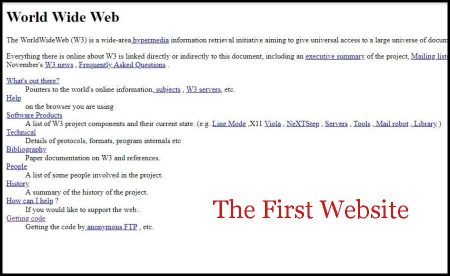Happy 30th Anniversary to the World Wide Web!
“Vague but exciting.”
This was how Sir Tim Berners-Lee’s boss responded to his proposal titled “Information Management: A Proposal,” submitted on this day in 1989, when the inventor of the World Wide Web was a 33-year-old software engineer. Initially, Berners-Lee envisioned “a large hypertext database with typed links,”named “Mesh,” to help his colleagues at CERN (a large nuclear physics laboratory in Switzerland) share information amongst multiple computers.
Berners-Lee’s boss allowed him time to develop the humble flowchart into a working model, writing the HTML language, the HTTP application, and WorldWideWeb.app— the first Web browser and page editor. By 1991, the external Web servers were up and running.
The Web would soon revolutionize life as we know it, ushering in the information age. Today, there are nearly 2 billion websites online. Whether you use it for email, homework, gaming, or checking out videos of cute puppies, chances are you can’t imagine life without the Web.
Not to be confused with the internet, which had been evolving since the 1960s, the World Wide Web is an online application built upon innovations like HTML language, URL “addresses,” and hypertext transfer protocol, or HTTP. The Web has also become a decentralized community, founded on principles of universality, consensus, and bottom-up design.
“There are very few innovations that have truly changed everything,” said Jeff Jaffe, CEO of the World Wide Web Consortium. “The Web is the most impactful innovation of our time.”

Birth of WWW and First Website
Tim Berners-Lee, a British scientist, invented the World Wide Web (WWW) in 1989, while working at CERN. The web was originally conceived and developed to meet the demand for automated information-sharing between scientists in universities and institutes around the world.
The first website at CERN – and in the world – was dedicated to the World Wide Web project itself and was hosted on Berners-Lee’s NeXT computer. In 2013, CERN launched a project to restore this first ever website: info.cern.ch.
On 30 April 1993, CERN put the World Wide Web software in the public domain. Later, CERN made a release available with an open licence, a more sure way to maximise its dissemination. These actions allowed the web to flourish.
In December 1990, an application called WorldWideWeb was developed on a NeXT machine at The European Organization for Nuclear Research (known as CERN) just outside of Geneva. This program – WorldWideWeb — is the antecedent of most of what we consider or know of as “the web” today.
In February 2019, in celebration of the thirtieth anniversary of the development of WorldWideWeb, a group of developers and designers convened at CERN to rebuild the original browser within a contemporary browser, allowing users around the world to experience the rather humble origins of this transformative technology.
This project was supported by the US Mission in Geneva through the CERN & Society Foundation.
Party like it’s 1989
Ready to browse the World Wide Web using WorldWideWeb?
Launch the WorldWideWeb browser.
Select “Document” from the menu on the side.
Select “Open from full document reference”.
Type a URL into the “reference” field.
Click “Open”.
Click here to jump in (and remember you need to double-click on links):
Views: 460




